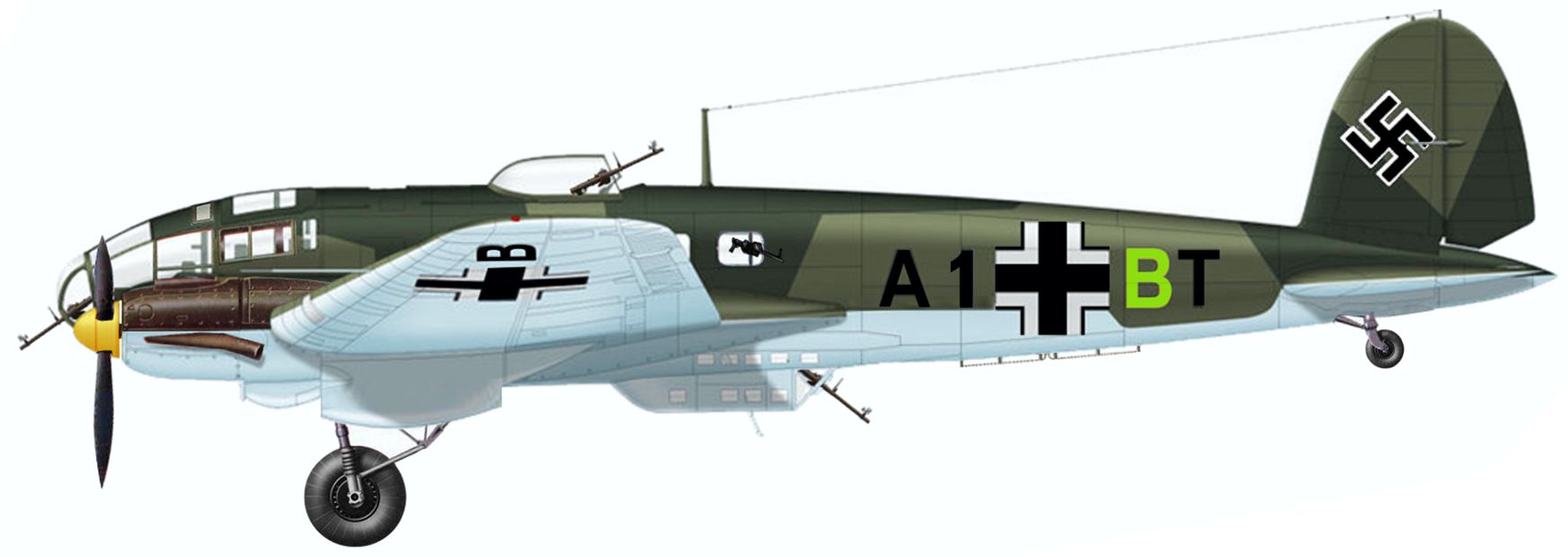
Heinkel HE-III-...................................................................................Specifications

This Heinkel III H1 of 9th Staffel, Kampfgeschwader 53 Legion Condor, played a role in the Battle of Britain in 1940. She was attacked by Spitfires on 15th of September 1940 during the big bombing raid on London and forced landed in Armentiers, France
This aircraft started out life, on paper at any rate, as a civil airliner. Under the guise of a civil registration, in the colours of Deutsche Lufthansa its 660hp BMW V1 engines first took these beautiful lines to the skies over Berlin Templehof Airport in January 1936, or at least that is what the world was lead to believe. Auctually the initial bomber prototype V1, inluding a glazed nose, flew in February 1935. The narrow fuselage of the V2 prototype D-ALIX "Rostock", with a solid, non glazed nose, could seat 10 passengers and freight could be stowed in a swing out nose compartment. By 1937 Lufthansa had 12 civil HE 111 machines. Mass production of this aircraft in the build up to the second world war and prelinary "practice" in the civil war in Spain were made possible by the strange political situation of the thirties, despite the bann imposed by the allies after World War One on Germany for building and developing weapons, British military intelligence was still convinced in 1938 that the HE 111 was a high speed airliner.
The basic airframe of the HE 111 was of very clean lines. Eclipse wings and tail with two neatly nacelled engines one on each wing. The aircraft enjoyed excellent flying qualities. Designed by the Günter brothers in 1934 as a larger follow up to the single engined HE 70 mail airliner of 1932, by the end of the 1944 over 7,300 examples had been built in Germany. A further 130 were produced after 1945 in Spain by CASA, serving with the Spanish Airforce well into the 1960s.
This "heavy" bomber aircraft formed the backbone of the bomber contingent to the Condor legion during the Spanish civil war. By the out set of the second world war it was found, if not by the authorities but certainly by the pilots who flew it or fought against it, to be hopelessly inadiquate and out-of-date. It lacked sufficent speed,armament or armed plating to face up to enemy fighters, especially during the Battle of Britain where Spitfires and Hurricanes of the R.A.F. caused heavy losses to Heinkel He 111 formations. Yet this aircraft stayed in service through out the war.
During the Spanish civil war the bombers were fast enough to evade what fighter opposition there was, flying unescorted bombing missions. This was the first time that any large scale bombing of towns and cities as a strategic measure had taken place and it was very effectful. These early triumphs continued during the first few months of World War Two, where no addequate enemy fighter opposition was meet. During the Battle of Britain however He 111 Sqadrons were desicrated. The blitz on London, Coventry and other British cities certainly took its toll. But by the end of the battle the He 111 was well and truely proven obsolite.
Compared to the "heavy" bombers of the allies this aircraft was more a "light" bomber. In its final form as the HE 111H-16 it could only carry a maxium of 5,512 lb of bombs over a range of arround 900 miles. This compared very infavourably to, for example the British Lancaster which over a range of 1,730 miles could carry 12,000 lb of bombs; or the Boeing B-17 which carried over 6,000 lb over a sector of 1,300 miles. The HE-111 had no gun turrets with an all-round view, being sadly under gunned mostly with fixed guns capable of very limited horrizontal and , vertical movement. The one offset gun "turret" in the extreme glazed nose did little to rectify this situation. Gunners relyed on chance when trying to shoot down enemy fighters and very often could not penetrate the armour of the opponent. A Persistent attacker was more often then not successful in downing the bomber.
Despite all of this the aircraft stayed in frontline service through-out the war. More proberly due to the fact that Germany had no other heavy bomber. Many cosmetic attempts were made to improve defensive armament and armour. More powerful engines ment a gradual increase in bomb load size. The aircraft was surprisingly versitile though, due to the basic airframe and ingenuity of Luftwaffe staff (not Leadership !!). The aircraft was used as a low level bomber, high level bomber, mine sweeper, mine layer, and in proberly one of the most exiting of all projects, as a tug for the Messerschmidt "Gigant" Glider, in a machine made up of two He 111 joined by a central wing, housing a fith engine. The HE-111 last production varient ment that the development of the aircraft had come full circle. The H-23 saboteur transport series, with two 1,776 hp Jumo 213A-1 engines, of 1944 carried eight parachutists.
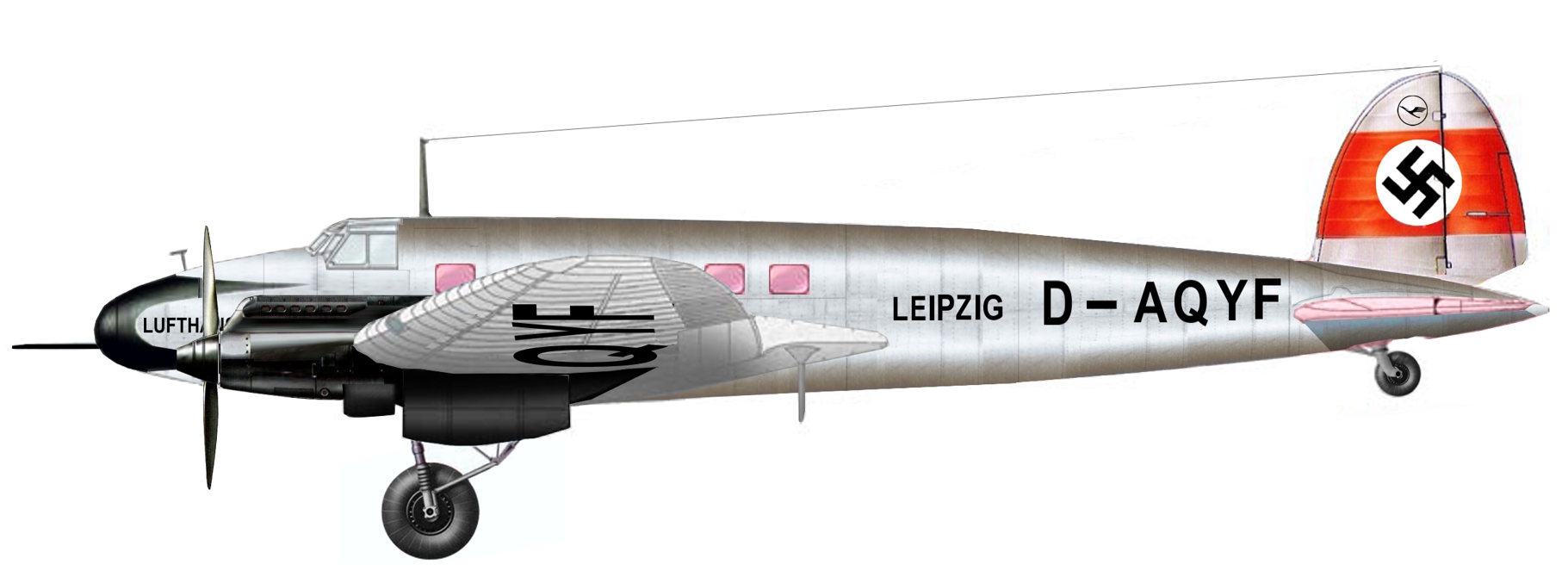
This Heinkel HE 111 C, D-AQYF "Leipzig" was one of six series C airliners, designated for Lufthansa. It had a swing open nose for freight and could seat 10 passengers. It's bare metal finish was in contrast to the grey finish of the first prototype V1 with glazed nose and the second prototype V2 "Rostock" pure airliner. These six series C aircraft together with the later G series aircraft flew with Lufthansa until 1940. The series G-0 was powered by the same BMW engines as the C series (later retrofitted with BMW 132H-1 radials). The G-3 had two BMW 132H-1 radial engines, whilst the G-4 was powered by Daimler Benz DB600G inverted-vee 950 hp (710 kW) engines, with the G-5 having the DB601B with a top speed of 410 km/h (255 mph). By 1937 Lufthansa had 12 HE 111 operational. The C series were underpowered and not favoured by the airline. All these airiner series aircraft were proberbly used in clandestine photo reconnaissance missions over Britain and France during 1939. In 1940 all of these aircraft were transferred to the Luftwaffe for training and transport duties.
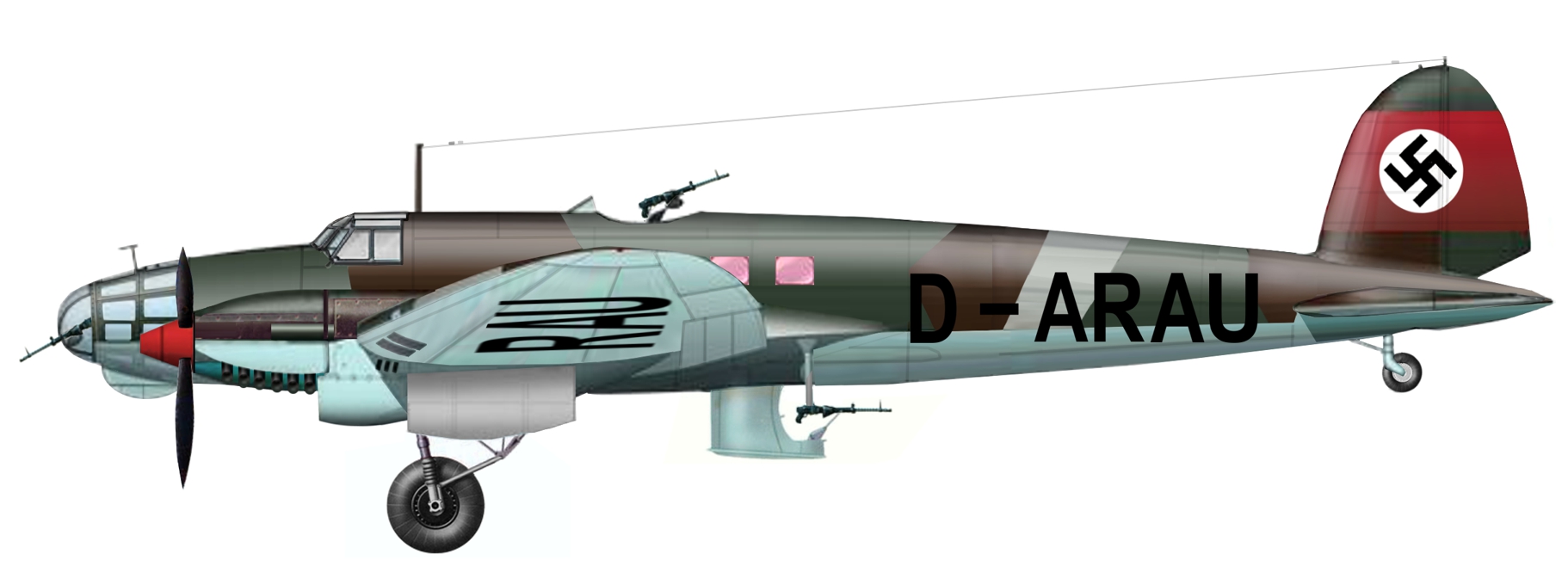
Heinkel He 111 B-1 in the markings of K / 88 (Kampfgruppe) Legion "Condor" in Spain. Note the flexible Ikaria turret under the fuselage. The ventral gunners "dustbin", known to Luftwaffe crews as the "Topf" (pot)could be lowered or left in the fuselage as required. Power plants were Daimler Benz supercharged 634 kW (850 hp) DB 600C engines. This particular aircraft, Werks nummer 1434 with the civil registration D-ARAU was used for Luftwaffe tests at Rechlin and crashed on the 24th March 1937.

Heinkel HE 111 G-3 was an airliner model designed for Lufthansa and delivered to the airline in 1939. From 1940 onwards these aircraft were transferred to the Luftwaffe. The aircraft featured the new straightened forewing and BMW 132H radial engines as "einheitstriebwerk", faciliating quick engine changes where-by the entire engine installation, including engine cowlings, were changed as one unit. This particular aircraft first flew as D-ACBS "Augsburg". After transferring to the Luftwaffe she was stationed at a training squadron, "Flugzeug Führer Schule B 34" at Kastrup Denmark. The aircraft made a belly landing near Kastrup on 16th November 1943. She was later returned to airworthiness. In 1944 she was stollen by a Dane who flew the aircraft to Sweden where she was shot down by the Swedish Air Force and totally destroyed. The would be "pilot" escaped unscaved.
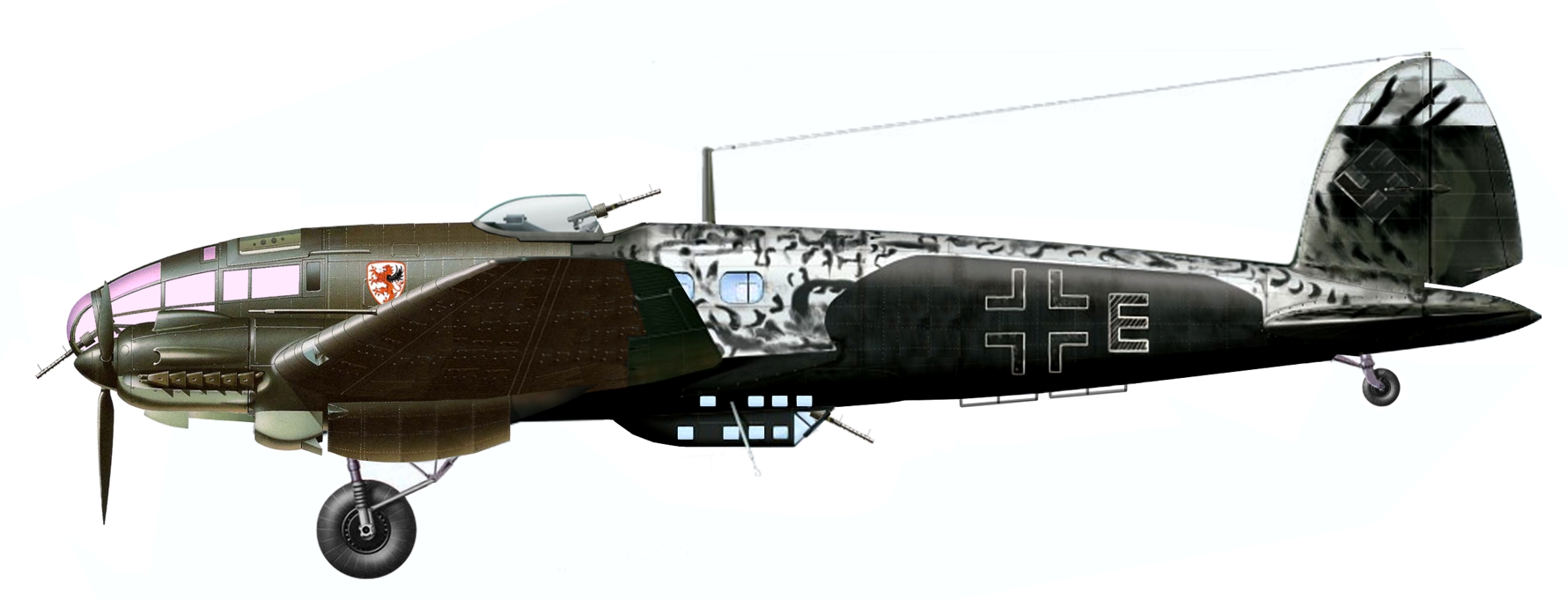
Heinkel He 111 P-2 of KG 55 "Greif" Kampfgeschwader as used during 1940 in night bombing raids against England from Villacoublay in France. Note the crudely painted aft fuselage with almost painted out unit markings and swastika. The geschwader arms on the front fuselage were the coat of arms of the town of Gießen where the KG 55 was originally based. The P-2 differed basically only in powerplant to the H series. The P series had Daimler-Benz DB 601A-1 liquid-cooled engines. These engines were later not readly avialable as they were needed for Me 109 and Me 110 during 1940s. The H series then incorporated Junkers Jumo 211 powerplants.
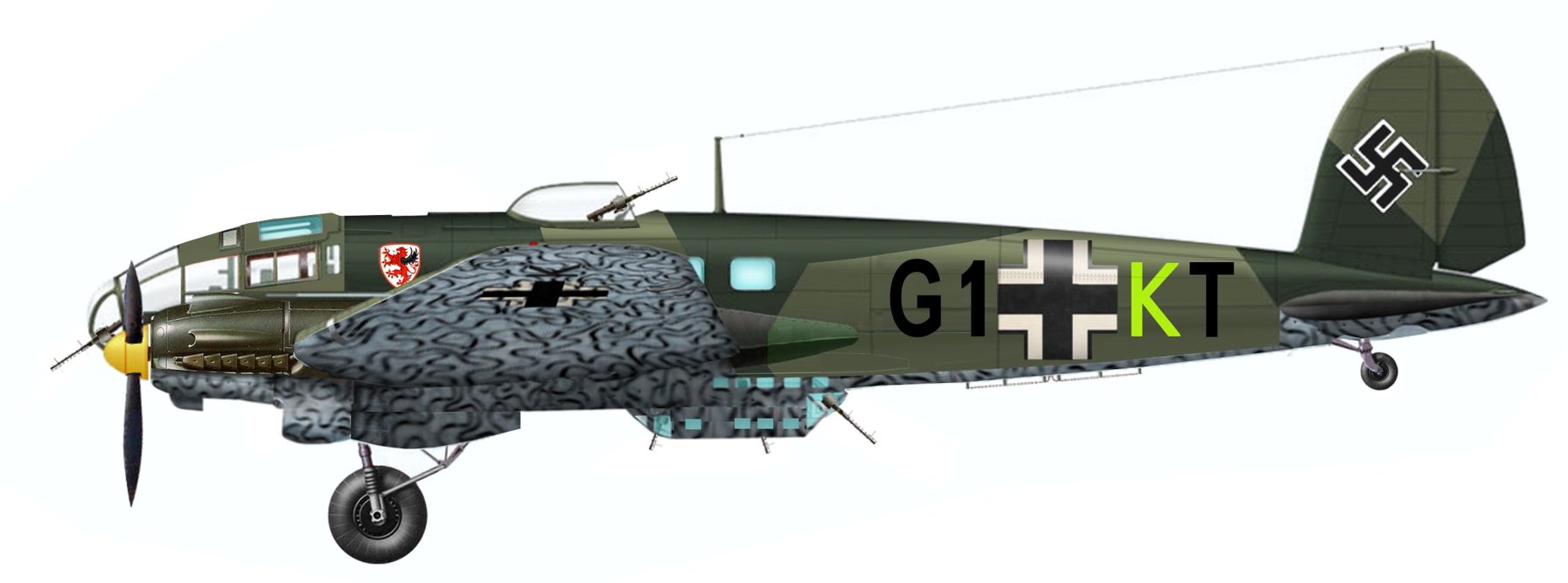
Heinkel He111 P of KG55 Greif October 1940 displaying an interesting under wing/fuselage camouflage. This marks a transition of operations. The day light attacks of the Battle of Britain inflicted such high losses in the bomber ranks that by October operations were switching to night raids. Aircraft were being dappled in black to hide there contours from enemy aircraft. Also additional defensive armament was carried.
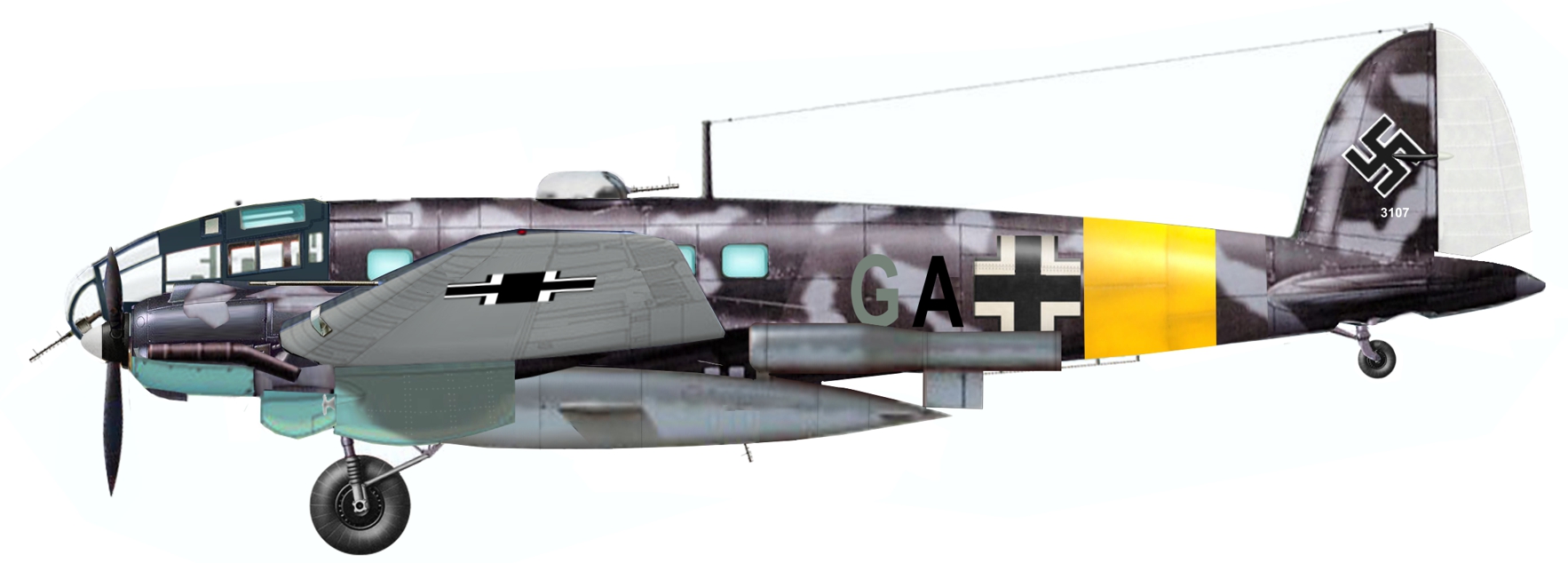
Heinkel He 111 H-22 configured to carry the Fieseler Fi 103 V1 flying bomb.